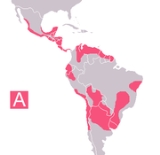
Trypanosomiasis
Overview
Trypanosomiasis or trypanosomosis is the name of several diseases in vertebrates caused by parasitic protozoa
n trypanosomes of the genus Trypanosoma
. Approximately 500,000 men, women and children in 36 countries of sub-Saharan Africa
suffer from human African trypanosomiasis which is caused by either Trypanosoma brucei gambiense or Trypanosoma brucei rhodesiense. The other human form of trypanosomiasis, called Chagas disease
, causes 21,000 deaths per year mainly in Latin America
.
Diagnosing African trypanosomiasis requires the documentation of T.brucei in blood smears, lymph node
aspirates, or CSF
.
Protozoa
Protozoa are a diverse group of single-cells eukaryotic organisms, many of which are motile. Throughout history, protozoa have been defined as single-cell protists with animal-like behavior, e.g., movement...
n trypanosomes of the genus Trypanosoma
Trypanosoma
Trypanosoma is a genus of kinetoplastids , a monophyletic group of unicellular parasitic flagellate protozoa. The name is derived from the Greek trypano and soma because of their corkscrew-like motion. All trypanosomes are heteroxenous and are transmitted via a vector...
. Approximately 500,000 men, women and children in 36 countries of sub-Saharan Africa
Africa
Africa is the world's second largest and second most populous continent, after Asia. At about 30.2 million km² including adjacent islands, it covers 6% of the Earth's total surface area and 20.4% of the total land area...
suffer from human African trypanosomiasis which is caused by either Trypanosoma brucei gambiense or Trypanosoma brucei rhodesiense. The other human form of trypanosomiasis, called Chagas disease
Chagas disease
Chagas disease is a tropical parasitic disease caused by the flagellate protozoan Trypanosoma cruzi. T. cruzi is commonly transmitted to humans and other mammals by an insect vector, the blood-sucking insects of the subfamily Triatominae most commonly species belonging to the Triatoma, Rhodnius,...
, causes 21,000 deaths per year mainly in Latin America
Latin America
Latin America is a region of the Americas where Romance languages – particularly Spanish and Portuguese, and variably French – are primarily spoken. Latin America has an area of approximately 21,069,500 km² , almost 3.9% of the Earth's surface or 14.1% of its land surface area...
.
- See main article: Human trypanosomiasisHuman trypanosomiasisHuman trypanosomiasis is a cutaneous condition caused by several species of trypanosomes, with skin manifestations usually being observed in the earlier stages of the disease as evanescent erythema, erythema multiforme, and edema, especially angioedema....
- Human African trypanosomiasis, transmitted by the tsetse flyTsetse flyTsetse , sometimes spelled tzetze and also known as tik-tik flies, are large biting flies that inhabit much of mid-continental Africa between the Sahara and the Kalahari deserts. They live by feeding on the blood of vertebrate animals and are the primary biological vectors of trypanosomes, which...
infected with Trypanosoma bruceiTrypanosoma bruceiTrypanosoma brucei is a parasitic protist species that causes African trypanosomiasis in humans and nagana in animals in Africa. There are 3 sub-species of T. brucei: T. b. brucei, T. b. gambiense and T. b. rhodesiense.These obligate parasites have two hosts - an insect vector and mammalian host...
, see African trypanosomiasis (sleeping sickness) - Human American trypanosomiasis, transmitted by the assassin bugReduviidaeReduviidae is a large, cosmopolitan family of predatory insects in the suborder Heteroptera...
infected with Trypanosoma cruziTrypanosoma cruziTrypanosoma cruzi is a species of parasitic euglenoid trypanosomes. This species causes the trypanosomiasis diseases in humans and animals in America...
, see Chagas diseaseChagas diseaseChagas disease is a tropical parasitic disease caused by the flagellate protozoan Trypanosoma cruzi. T. cruzi is commonly transmitted to humans and other mammals by an insect vector, the blood-sucking insects of the subfamily Triatominae most commonly species belonging to the Triatoma, Rhodnius,...
- Human African trypanosomiasis, transmitted by the tsetse fly
Diagnosing African trypanosomiasis requires the documentation of T.brucei in blood smears, lymph node
Lymph node
A lymph node is a small ball or an oval-shaped organ of the immune system, distributed widely throughout the body including the armpit and stomach/gut and linked by lymphatic vessels. Lymph nodes are garrisons of B, T, and other immune cells. Lymph nodes are found all through the body, and act as...
aspirates, or CSF
Cerebrospinal fluid
Cerebrospinal fluid , Liquor cerebrospinalis, is a clear, colorless, bodily fluid, that occupies the subarachnoid space and the ventricular system around and inside the brain and spinal cord...
.
Unanswered Questions

